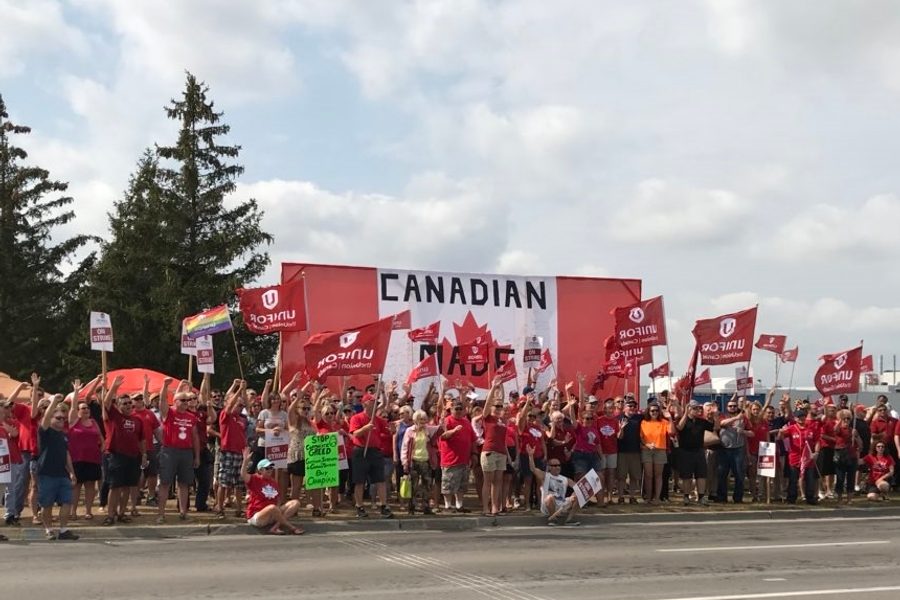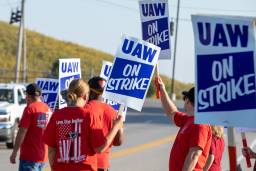
This post first appeared at Labor Notes.
As negotiators from Canada, the U.S., and Mexico carry out secretive talks aimed at fixing NAFTA, a strike at an Ontario auto plant shows how difficult it can be to challenge the power amassed by corporations thanks to the trade deal.
The 2,800 members of Unifor Local 88 walked off the job September 17 at the CAMI assembly plant in Ingersoll seeking contract language to secure their jobs.
They returned a month later without it. Their contract is similar to the one reached at all the other Big Three plants in Ontario in fall 2016.
CAMI still produces the popular Chevrolet Equinox SUV, but in July General Motors, the plant’s owner, moved the Terrain SUV to Mexico, costing 600 jobs in Ingersoll. This was despite the fact that in 2015, GM invested $560 million at CAMI to build a new weld shop, a move workers thought would protect their jobs.
The Equinox is made in two plants in Mexico, too. Local 88 wanted contractual assurance that its plant would remain the vehicle’s “lead producer.”
Unifor National President Jerry Dias said of his decision to settle without job guarantees, “At the highest levels of General Motors corporate in Detroit, they coldly refused.” With the strike costing the company $5 million a day, GM threatened to shift all Equinox production to Mexico.
There seemed little alternative to settling for Local 88 barring more radical tactics, which were never under discussion by Unifor leaders.
BUY-OUTS FOR LOST JOBS
The new pact includes more money for early retirement and for buyouts for younger workers, and increases by $100 million the severance and retirement costs GM would pay for a plant closing.
The four-year agreement will see a 4 percent wage increase plus $8,000 in lump sum payments and a $6,000 signing bonus.
Job security will no doubt still be an issue come 2021. The future of the auto industry in Canada remains up in the air.
Canadian employment at the Big Three automakers has been cut by more than half since NAFTA, from 52,000 in 1993 to just 23,000 last year. In the current renegotiation of NAFTA both Canada and Mexico have rejected U.S. demands on content requirements that Canadians say could sink the industry in Canada.
GM posted $9.4 billion in profits last year and the CAMI plant itself is hugely profitable, one of the most productive and efficient in North America with numerous awards for quality.
It was the first strike at GM in Canada since 1996 and first legal strike at CAMI since 1992, with wildcat strikes occurring in 1995, 1999, and 2014.
IN THE SHADOW OF NAFTA
It was not lost on CAMI workers, auto workers across Ontario, or the Ingersoll community how the timing of the strike lined up with the ongoing NAFTA talks.
“When you have a plant in Mexico that pays their workers $2 an hour and they can’t even afford to buy the cars that they build, then you’ve got a real problem,” Dias told Canada’s BNN. “So, CAMI, this whole strike is the poster child for what’s wrong with NAFTA.”
Unifor has called for a better deal for workers in Mexico and the U.S., too. The union supported the Canadian government’s demand that right-to-work laws in the U.S. be scrapped, and a Unifor delegation recently visited Mexico to meet with labor activists, calling for parity of Mexican wages and truly independent unions.
Auto workers in Mexico belong to a federation closely aligned with the ruling party. This federation, the CTM, is a company union, doing nothing to force up wages but acting ruthlessly against attempts to form independent unions. In fact, many workers don’t even know whether their factory is unionized or not.
LOCAL SUPPORT
Retired Local 88 president Cathy Austin was on the CAMI picket line for five weeks in 1992. She says that strike “did not have support from the community like this one does; they have been overwhelmed by the support.”
An October 5 rally outside of the plant drew more than 500 people. Even a contingent of United Auto Workers members from Rochester, New York, visited the lines.
And though the strike caused shutdowns of auto parts suppliers in the area, Local 88 Trustee Kim Crump said the closures and layoffs actually increased community support, even among non-union parts workers.
[Gerard Di Trolio is a writer living in Toronto who covers labor and politics. Doug Nesbitt is an editor at Rankandfile.ca and a former union organizer.]

I hope you found this article important. Before you leave, I want to ask you to consider supporting our work with a donation. In These Times needs readers like you to help sustain our mission. We don’t depend on—or want—corporate advertising or deep-pocketed billionaires to fund our journalism. We’re supported by you, the reader, so we can focus on covering the issues that matter most to the progressive movement without fear or compromise.
Our work isn’t hidden behind a paywall because of people like you who support our journalism. We want to keep it that way. If you value the work we do and the movements we cover, please consider donating to In These Times.



